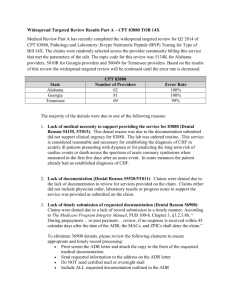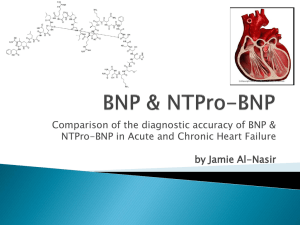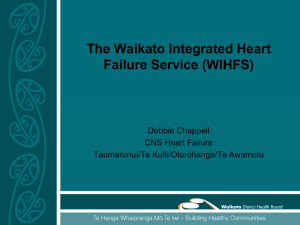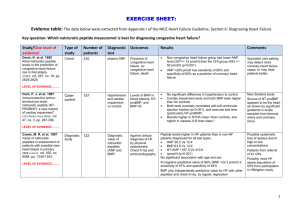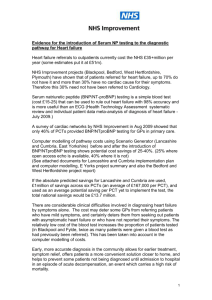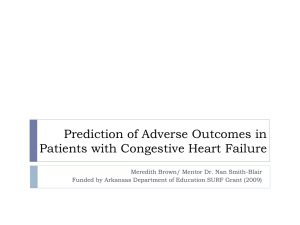BIOMARKERS IN HEART FAILURE - Philippine Heart Association
advertisement
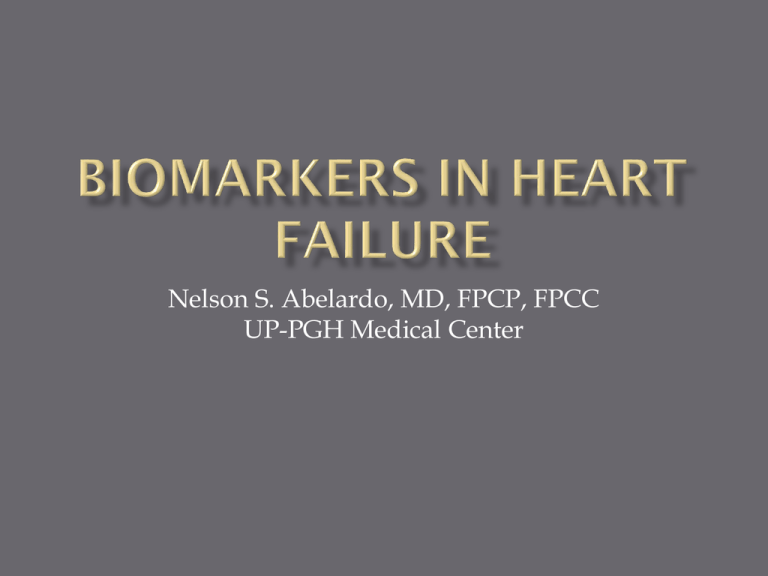
Nelson S. Abelardo, MD, FPCP, FPCC UP-PGH Medical Center Accurate, repeated measurements must be available to clinicians at reasonable cost with short turn-around time Biomarker must provide information that is not already available from a careful clinical assessment Measured level should aid in clinical decision making Morrow & de Lemos Heart failure, is a major and growing public health problem and appears to result not only from cardiac overload or injury but also from a complex interplay among genetic, neurohormonal, inflammatory, and biochemical changes acting on cardiac myocytes, the cardiac interstitium or both. An increasing number of enzymes, hormones, biologic substances, and other markers of cardiac stress and malfunction, as well as myocyte injury — collectively referred to as biomarkers — appear to have growing clinical importance. Inflammation is important in the pathogenesis and progression of many forms of heart failure, and biomarkers of inflammation have become the subject of intense C-reactive protein, a protein that appears in the serum in a variety of inflammatory conditions detectable in 30 of 40 patients with chronic heart failure and heart failure was more severe in those with higher levels of Creactive protein. C-reactive protein was described as an acute-phase reactant synthesized by hepatocytes in response to the proinflammatory cytokine interleukin-6 Multivariate analysis indicated that increased C-reactive protein level is an independent predictor of adverse outcomes in patients with acute or chronic heart failure. Framingham Heart Study, C-reactive protein (as well as cytokines interleukin-6 and TNF-α) was noted to identify asymptomatic older subjects in the community at high risk of the future development of heart failure. CRP exert direct adverse effects on vascular endothelium by reducing nitric-oxide release and increasing endothelin1 production Induces expression of endothelial adhesion molecules (impt role in vascular diseases – potential target for tx) Elevated levels of CRP lacks specificity (eg acute and chronic infection, cigarette smoking, ACS, and active inflammatory states frequently assoc with inc levels of CRP In 1990, Levine et al. - elevated levels of circulating TNF-α in patients with heart failure. TNF-α and three interleukins (interleukins 1, 6, and 18) are considered to be proinflammatory cytokines and are produced by nucleated cells in the heart. The cytokine hypothesis of heart failure proposes that a precipitating event — such as ischemic cardiac injury — triggers innate stress responses, including elaboration of proinflammatory cytokines, and that the expression of these cytokines is associated with deleterious effects on left ventricular function and accelerates the progression of heart failure. Proinflammatory cytokines - myocyte apoptosis and necrosis; interleukin-6 - hypertrophic response in myocytes TNF-α - LV dilatation by activation of matrix metalloproteinases. Interleukin-6 and TNF-α levels could be used to predict the future development of heart failure in asymptomatic elderly subjects in one study Blockade of TNF-α has not resulted in clinical benefit in patients with heart failure TNF-α receptor family expressed on a variety of cells, including myocytes. When activated it mediates apoptosis and plays an important role in the development and progression of heart failure. Elevated serum levels reported in patients with heart failure, and high levels associated with severe disease. The inhibition of soluble Fas in animals reduces postinfarction ventricular remodeling and improves survival. Pharmacologic reduction of Fas still in its infancy but may be a new direction in the treatment of heart failure. Nonspecific immunomodulating agent — pentoxifylline or IV immunoglobulin— reduces plasma levels of Fas and CRP and improved LV function in ischemic or DCM Results from an imbalance bet reactive oxygen species (superoxide anion, hydrogen peroxide, hydroxyl radical) and endogenous antioxidant defense mechanisms with deleterious effects on endothelial function and pathogenesis / progression of HF Damage cellular proteins and cause myocyte apoptosis and necrosis. Assoc with arrhythmias and endothelial dysfunction through reduction of NOS activity and inactivation of nitric oxide Inflammation and immune activation, RAAS , SNS and increased catecholamine levels and peroxynitrite formed from the interaction of the superoxide anion and nitric oxide all may increase oxidative stress Plasma-oxidized LDL, malondialdehyde and myeloperoxidase (an index of leukocyte activation), urinary levels of biopyrrins (oxidative metabolites of bilirubin), and isoprostane levels in plasma and urine - surrogate markers of ROS Increasing evidence that xanthine oxidase (catalyst for hypoxanthine and xanthine) plays a pathol role in heart failure. Uric acid elevated with increased xanthine oxidase activity and correlate with impaired hemodynamics and independently predict adverse prognosis in HF. Although more studies are required, UA may prove to be a simple, useful, albeit nonspecific, clinical indicator of excess oxidative stress. Extracellular matrix provides a “skeleton” for myocytes (for size / shape) brought about by a balance between matrix metalloproteinases (proteolytic enzymes that degrade fibrillar collagen) and tissue inhibitors of metalloproteinases. Enzyme greater than inhibitors associated with ventricular dilatation and remodeling Abnormal increase in collagen synthesis deleterious to cardiac function bec excessive fibrosis impairs ventricular function. The propeptide procollagen type I is a serum biomarker of collagen biosynthesis. Increased extracellular-matrix breakdown or excessive collagen synthesis associated with impaired LV function and adverse clinical outcomes in patients with heart failure and are important targets of therapy. 1960s reports that patients with HF had abnormally elevated levels of plasma norepinephrine at rest and further elevations occurred during exercise. The urinary excretion of norepinephrine was also increased. Cohn et al. subsequently demonstrated that plasma NE level was an independent predictor of mortality Swedberg et al. observed that the renin–angiotensin–aldosterone system becomes activated in patients with heart failure Endothelin-1 is a powerful stimulant of vascular smooth-muscle contraction and proliferation and ventricular and vessel fibrosis and is a potentiator of other neurohormones. Plasma levels increased with HF and correlate directly with pulmonary artery pressure, disease severity, and mortality Val-HeFT investigators showed the most powerful predictors of mortality and hospitalization for HF were BNP, big endothelin-1, norepinephrine, endothelin-1, plasma renin activity, and aldosterone. among 4300 patients RALES found that administration of spironolactone in patients with AMI reduced myocardial collagen synthesis, as reflected by plasma procollagen type III, as well as postinfarct adverse left ventricular remodeling suggesting beneficial action of spironolactone in patients with severe heart failure. Arginine vasopressin is a nonapeptide synthesized in the hypothalamus and stored in the posterior pituitary gland and that has antidiuretic and vasoconstrictor properties. Excess release of arginine vasopressin intensifies heart failure associated with dilutional hyponatremia, fluid accumulation, and systemic vasoconstriction. Whereas plasma levels of arginine vasopressin are elevated in patients with acute or chronic heart failureand are associated with poor clinical outcomes, blockade of the vasopressin 2 receptor relieves acute symptoms but does not appear to alter the natural history of severe heart failure. Thus, it is not yet clear whether the vasopressin 2 receptor should be considered to be a therapeutic target. Myocyte injury - severe ischemia but it is also a consequence of stresses on the myocardium such as inflammation, oxidative stress and neurohormonal activation. Cardiac troponins T and I - emerged as sensitive and specific markers of myocyte injury Improved greatly the diagnosis, risk stratification, and care of patients with ACS. Modest elevations of cT I levels are also found in patients with HF without ischemia. Horwich et al – cT I was detectable (≥0.04 ng /ml) in approx half of 240 patients with advanced, chronic heart failure without ischemia. cT I remained an independent predictor of death. cT T levels > 0.02 ng /ml chronic HF associated with a hazard ratio for death of more than 4 Latini et al – with standard assay, c T T detectable in 10% of pts chronic HF but with high-sensitivity assay, it was detectable in 92% of these patients As sensitivity of c T analysis increases further, it will probably be detectable in the entire population and along with the natriuretic peptides it will be used routinely to assess the prognosis and response to treatment of patients with heart failure. Myosin light chain 1, heart fatty-acid binding protein, and CK MB fraction — also circulate in stable patients with severe HF Like c T T, presence of these myocardial proteins in the serum is an accurate predictor of death or hospitalization for HF Need to be validated with more studies precursor of BNP and N-terminal pro–brain natriuretic peptide (NT-pro-BNP) - pre–prohormone BNP, a 134amino-acid peptide synthesized in the myocytes and cleaved to prohormone BNP of 108 amino acids. released during hemodynamic stress when ventricles are dilated, hypertrophic, or subject to increased wall tension. cleaved by circulating endoprotease (corin) into two polypeptides: the inactive NT-pro-BNP and the bioactive BNP BNP causes arterial vasodilation, diuresis, and natriuresis, and reduces the RAAS and SNS Natriuretic peptides - cleared by kidney Hypervolemia and HPN of renal failure enhance secretion BNP Mod increase in circ BNP with age, in relation to myocardial fibrosis or renal dysfunction Pulmonary HPN may increase the plasma level of BNP and varies inversely with BMI BNP and NT-pro-BNP assays are commercially available and are the most widely tested Recommended in current guidelines most useful in the evaluation of pts with dyspnea presenting to the ED where POCT may provide the advantages of convenience and rapid turnaround times facilitating clinical management Maisel et al showed in the Breathing Not Properly study that BNP levels greatly increased the accuracy of the diagnosis of HF in pts presenting to ED with dyspnea; level > 100 pg/ml HF unlikely but level >400 pg/ml makes the diagnosis likely. Versus standard care, a strategy of single measurement of BNP or NT-pro-BNP in pts with acute dyspnea was assoc with shorter / lower cost hospital stay Decisions for hospital admission or referral to an OP clinic are facilitated by natriuretic peptide levels BNP level - also an accurate predictor of survival in acute decompensated HF irrespective of LVEF Adjusting for baseline variables, an almost linear relation bet BNP and in-hospital mortality (Fonarow et al for ADHERE) BNP - useful in the diagnosis and risk stratification of pts with chronic HF and are better predictor of death than is plasma norepinephrine or endothelin-1 Systolic Heart Failure Treatment Supported by BNP (STARS–BNP) trial by Jourdain et al randomly assigned outpatients with NYHA cl II/III HF to current clinical guidelines (control group) or to goal of decreasing BNP < 100 pg/ml primary end point (HF death or hosp admission for HF) occurred in 24% of patients in whom the BNP level was lowered vs 52% of the control group (p < 0.001) predischarge level of BNP was a strong, independent predictor of postdischarge outcomes patients with HF whose BNP level does not decline to < 600 pg/ml should receive intensified treatment before discharge useful in screening asymptomatic subjects at risk of HF such as elderly and those with HPN, DM & asymptomatic CAD may also be used to screen for acute or late cardiotoxic effects associated with cancer chemotherapy peptide of 52 amino acids and a component of precursor, proadrenomedullin, which is synthesized and present in the heart, adrenal medulla, lungs, and kidneys potent vasodilator, with inotropic and natriuretic properties production is stimulated by both cardiac pressure and volume overload circulating adrenomedullin is elevated in patients with HF and is higher with more severe HF member of the interleukin-1 receptor family secreted by cultured monocytes subjected to mechanical strain with stretch Increased ST2 seen with severe HF. In ED pts with STEMI and dyspnea, ST2 levels were strongly predictive of mortality with HF, increased ST2 during a 2-week period was an independent predictor of subsequent death or the need for cardiac transplantation BNP and NT-pro-BNP – excellent assays available and with substantial experience adrenomedullin and ST2 – analytical methods not yet standardized but maybe supplementary to the ANP’s chromogranin A, a polypeptide hormone produced by the myocardium, with potent neg inotropic properties and elevated plasma levels in patients with HF galectin-3, a protein produced by activated macrophages, plasma levels reported to predict adverse outcomes in patients with HF osteoprotegerin, a member of the TNF receptor superfamily implicated in development of LV dysfunction and predicts survival in pts with HF after AMI Traditional approach to the classification of HF focused on the pathological cause of failure of the cardiac pump (CAD), pathophysiological characteristics (e.g., systolic HF), and the acuity and severity of HF A biomarker profile may be a valuable addition to this approach Biomarkers for heart failure are usually considered individually. A multimarker strategy may be useful in refining risk stratification among patients with acute coronary syndromes and there is a growing interest in this approach for categorizing heart failure many appear to provide important information regarding the pathogenesis of heart failure identification of subjects at risk for heart failure appear to be useful in risk stratification useful in the diagnosis of heart failure aid in monitoring therapy. may be risk factors themselves and therefore may be potential targets of therapy. Biomarkers in Heart Failure June 2011 HFSA 2010 GUIDELINE RECOMMENDATION 4.3 Routine determination of plasma beta type natriuretic peptide (BNP) or N-terminal pro-BNP (NT-proBNP) concentration as part of screening evaluation for structural heart disease in asymptomatic patients is not recommended
